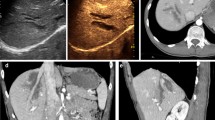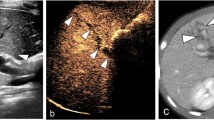Abstract
Computed tomography (CT) still represents the preferred imaging method in the assessment of patients presenting with multiple trauma. Nevertheless, in patients with low-energy abdominal trauma, the use of CT is debated because of the possible unnecessary radiation exposure. Accordingly, conventional ultrasound (US) imaging has been increasingly employed as the initial imaging modality in the workup of minor traumatic emergency conditions. Focused assessment with sonography for trauma is widely used to detect free intra-abdominal fluid, but its role is controversial, because the absence of free fluid does not exclude the presence of injuries to abdominal organ. Injection of an ultrasound contrast agent (UCA) may give the radiologist relevant additional information to that obtained with conventional US. Thus, in trauma patients, following early assessment with conventional US imaging, a contrast-enhanced US (CEUS) can provide a more reliable evaluation of solid organ injuries and related vascular complications, including active bleeding, pseudoaneurysms, and artero-venous fistulas. CEUS cannot replace abdominal CT, but it represents a noninvasive and repeatable imaging tool capable of providing a reliable assessment of trauma severity and expedite the patient’s treatment.







Similar content being viewed by others
References
Scalea TM, Rodriguez A, Chiu WC et al (1999) Focused Assessment with Sonography for Trauma (FAST): results from an international consensus conference. J Trauma 46:466–472
Bode PJ, Edwards MJ, Kruit MC et al (1999) Sonography in a clinical algorithm for early evaluation of 1671 patients with blunt abdominal trauma. Am J Roentgenol 172:905–911
Korner M, Krotz MM, Degenhart C et al (2008) Current role of emergency US in patients with major trauma. Radiographics 28:225–242
Lingawi SS, Buckley AR (2000) Focused abdominal US in patients with trauma. Radiology 217:426–429
Valentino M, Serra C, Pavlica P et al (2007) Contrast-enhanced ultrasound for blunt abdominal trauma. Semin Ultrasound CT MR 28:130–140
Shackford SR, Rogers FB, Osler TM et al (1999) Focused abdominal sonogram for trauma: the learning curve of nonradiologist clinicians in detecting hemoperitoneum. J Trauma 46:553–564
Poletti PA, Wintermark M, Schnyder P, Becker CD (2002) Traumatic injuries: role of imaging in the management of polytrauma victim (conservative expectation). Eur Radiol 12:969–978
Wilson SR, Burns PN (2010) Microbubble-enhanced US in body imaging: what role? Radiology 257:24–39
Burns PN, Wilson SR (2006) Microbubble contrast for radiological imaging: 1 Principles. Ultrasound Q 22:5–13
Bertolotto M, Catalano O (2009) Contrast-enhanced ultrasound: past, present, and future. Ultrasound Clin 4:339–367
Leen E, Moug SJ, Horgan P (2004) Potential impact and utilization of ultrasound contrast media. Eur Radiol 14(Suppl 8):P16–P24
Thorelius L (2007) Emergency real-time contrast-enhanced ultrasonography for detection of solid organ injuries. Eur Radiol 17(Suppl 6):F107–F111
Cokkinos D, Antypa E, Kalogeropuolos I et al (2013) Contrast-enhanced ultrasound performed under urgent condition. Indications, review of the technique, clinical examples and limitations. Insights Imaging 4:185–198
Wilson SR, Burns PN (2006) Microbubble contrast for radiological imaging: 2 Applications. Ultrasound Q 22:15–18
Pinto F, Miele V, Scaglione M, Pinto A (2013) The use of contrast-enhanced ultrasound in blunt abdominal trauma: advantages and limitations. Acta Radiol [Epub ahead of print]
Madsen HHT (2008) Ultrasound contrast: the most important innovation in ultrasound in recent decades. Acta Radiol 49:247–248
Bauer A, Solbiati L, Weissman N (2002) Ultrasound imaging with SonoVue: low mechanical index real-time imaging. Acad Radiol 9(Suppl 2):S282–S284
Mihalik JE, Smith RS, Toevs CC et al (2012) The use of contrast-enhanced ultrasound for the evaluation of solid abdominal organ injury in patients with blunt abdominal trauma. J Trauma Acute Care Surg 73:1100–1105
Wilson SR, Greenbaum LD, Goldberg BB (2009) Contrast-enhanced ultrasound: what is the evidence and what are the obstacles? AJR Am J Roentgenol 193:55–60
Piscaglia F, Bolondi L (2006) The safety of Sonovue in abdominal applications: retrospective analysis of 23,188 investigations. Ultrasound Med Biol 32:1369–1375
Bokor D, Chambers JB, Rees PJ et al (2001) Clinical safety of SonoVue, a new contrast agent for ultrasound imaging, in healthy volunteers and in patients with chronic obstructive pulmonary disease. Invest Radiol 36:104–109
Li W, Tang J, Lv F et al (2010) Effectiveness and safety of CEUS-guided haemostatic injection for blunt splenic trauma: an animal experiment. Radiol Med 115:1080–1086
Piscaglia F, Nolsøe C, Dietrich CF et al (2011) The EFSUMB guidelines and recommendations on the clinical practice of contrast enhanced ultrasound (CEUS). Update 2011 on non-hepatic applications. Ultraschall Med 32:1–27
Bolondi L, Correas JM, Lencioni R et al (2007) New perspectives for the use of contrast-enhanced liver ultrasound in clinical practice. Dig Liv Dis 39:187–195
Catalano O, Cusati B, Nunziata A et al (2006) Active abdominal bleeding: contrast-enhanced sonography. Abdom Imaging 31:9–16
Glen P, MacQuarrie J, Imrie CW, Leen E (2004) A novel application of ultrasound contrast: demonstration of splenic arterial bleeding. Br J Radiol 77:333–334
Lv F, Tang J, Luo Y et al (2011) Contrast-enhanced ultrasound imaging of active bleeding associated with hepatic and splenic trauma. Radiol Med 116:1076–1082
Poletti PA, Platon A, Becker CD et al (2004) Blunt abdominal trauma: does the use of a second-generation sonographic contrast agent help to detect solid organ injuries? AJR Am J Roentgenol 183:1293–1301
Valentino M, Serra C, Zironi G et al (2006) Blunt abdominal trauma: emergency contrast-enhanced sonography for detection of solid organ injuries. AJR Am J Roentgenol 186:1361–1367
Valentino M, Serra C, Pavlica P et al (2008) Blunt abdominal trauma: diagnostic performance of contrast-enhanced US in children: initial experience. Radiology 246:903–909
Regine G, Atzori M, Miele V et al (2007) Second-generation sonographic contrast agents in the evaluation of renal trauma. Radiol Med 112:581–587
McArthur C, Baxter GM (2012) Current and potential renal applications of contrast-enhanced ultrasound. Clin Radiol 67:909–922
Harvey CJ, Sidhu PS (2010) Ultrasound contrast agents in genitourinary imaging. Ultrasound Clin 5:489–506
Pinto F, Bode PJ, Tonerini M et al (2006) The role of the radiologist in the management of politrauma patients. Eur J Radiol 59:315–316
Mirvis SE (2000) Role of CT in diagnosis and management of spleen injury. Appl Radiol 29:7–12
Harkanyi Z (2013) Potential applications of contrast-enhanced ultrasound in pediatric patients. Ultrasound Clin 8:403–422
Piskunowicz M, Kosiak W, Batko T (2012) Intravenous application of second-generation ultrasound contrast agents in children: a review of the literature. Ultraschall Med 33:135–140
Coleman JL, Navid F, Furman WL, McCarville MB (2014) Safety of ultrasound contrast agents in the pediatric oncologic population: a single-institution experience. AJR Am J Roentgenol 202:966–970
Sellars ME, Deganello A, Sidhu PS (2014) Paediatric contrast-enhanced ultrasound (CEUS): a technique that requires co-operation for rapid implementation into clinical practice. Ultrascall Med 35:203–206
Darge K, Papadopoulou F, Ntoulia A et al (2013) Safety of contrast-enhanced ultrasound in children for non-cardiac applications: a review by the Society for Pediatric Radiology (SPR) and the International Contrast Ultrasound Society (ICUS). Pediatr Radiol 43:1063–1073
Romanini L, Passamonti M, Aiani L et al (2007) Economic assessment of contrast-enhanced ultrasonography for evaluation of focal liver lesions: a multicenter Italian experience. Eur Radiol 17(Suppl 6):F99–F106
Tranquart F, Correas JM, Ladam Marcus V et al (2009) Real-time contrast-enhanced ultrasound in the evaluation of focal liver lesions: diagnostic efficacy and economical issues from a French multicentric study. J Radiol 90(1 Pt 2):109–122
Catalano O, Aiani L, Barozzi L et al (2009) CEUS in abdominal trauma: multi-center study. Abdom Imaging 34:225–234
Catalano O, Lobianco R, Sandomenico F et al (2004) Real-time, contrast-enhanced sonographic imaging in emergency radiology. Radiol Med 108:454–469
Valentino M, Ansaloni L, Catena F et al (2009) Contrast-enhanced ultrasonography in blunt abdominal trauma: considerations after 5 years of experience. Radiol Med 114:1080–1093
Quaia E (2007) Microbubble ultrasound contrast agents: an update. Eur Radiol 17:1995–2008
Moore EE, Cogbill TH, Jurkovich GJ et al (1995) Organ injury scaling: spleen and liver (1994 revision). J Trauma 38:323–324
Miele V, Buffa V, Stasolla A et al (2004) Contrast enhanced ultrasound with second generation contrast agent in traumatic liver lesions. Radiol Med 108:82–91
Tang J, Li W, Lv F et al (2009) Comparison of gray-scale contrast-enhanced ultrasonography with contrast-enhanced computed tomography in different grading of blunt hepatic and splenic trauma: an animal experiment. Ultrasound Med Biol 35:566–575
Manetta R, Pistoia ML, Bultrini C et al (2009) Ultrasound enhanced with sulphur-hexafluoride-filled microbubbles agent (SonoVue) in the follow-up of mild liver and spleen trauma. Radiol Med 114:771–779
Conflict of interest
The authors have no conflict of interest to declare.
Author information
Authors and Affiliations
Corresponding author
Rights and permissions
About this article
Cite this article
Pinto, F., Valentino, M., Romanini, L. et al. The role of CEUS in the assessment of haemodynamically stable patients with blunt abdominal trauma. Radiol med 120, 3–11 (2015). https://doi.org/10.1007/s11547-014-0455-3
Received:
Accepted:
Published:
Issue Date:
DOI: https://doi.org/10.1007/s11547-014-0455-3




